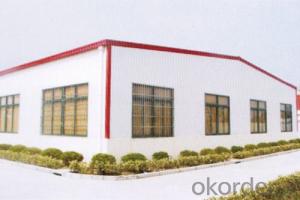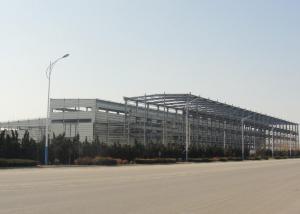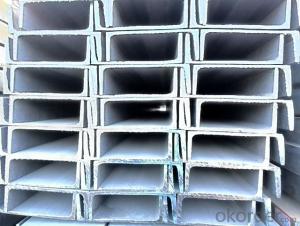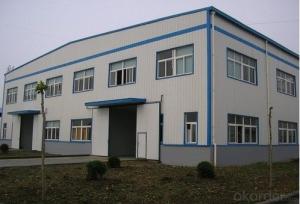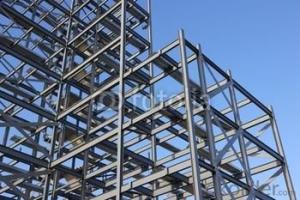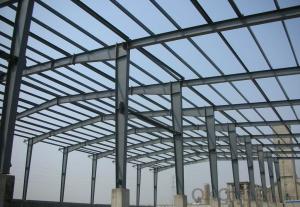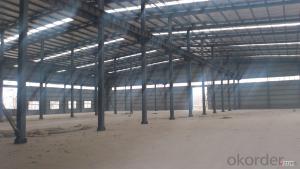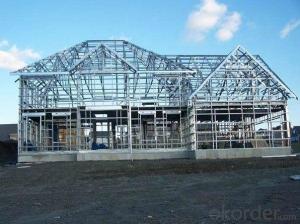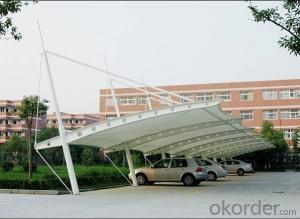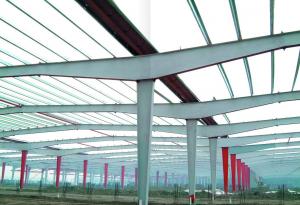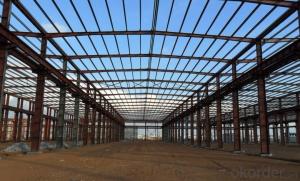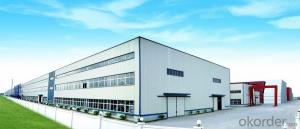Professional galvanized manufacturer steel structure workshop with ISO 9001 Certificate
- Loading Port:
- China Main Port
- Payment Terms:
- TT OR LC
- Min Order Qty:
- -
- Supply Capability:
- -
OKorder Service Pledge
OKorder Financial Service
You Might Also Like
Fast construction metal shed sale with low cost
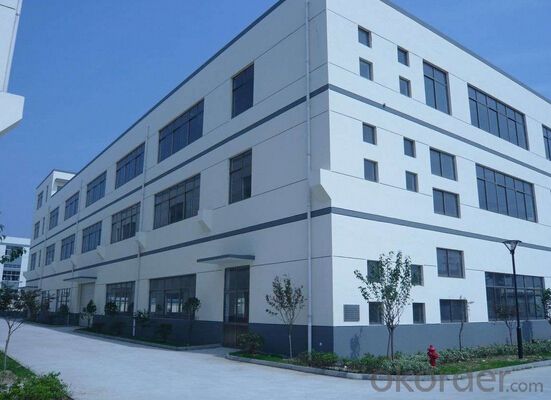
Specification
1. Durable
2. Light Weight
3. Excelent quality
4. Atractive appearance
5.Easy and fast to install
6. Resistant 8-9 earthquake grade
7. Span life : over 50 years
8. Eco-friendly material: can be used for several times and can be recycled
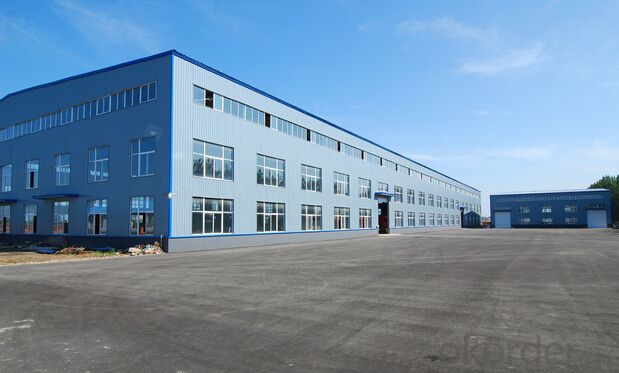
| Name | Steel structure building | |
| Dimension | length | H beam 4000-15000 mm |
| thickness | web plate 6 -32 mm web plate 6 -40 mm | |
| height | 200 -1200 mm | |
| Color | avalible | |
| size | according to your requirement | |
| Advantages | 1. lower cost and beautiful outlook 2. high safty performance 3. easy to assemble and disassemble 4.installation with installation of experienced engineer 5. None -pollution | |
| Main componet | base | cement and steel foundation bolts |
| main frame | H beam | |
| material | Q 235 B , Q 345 B our main material | |
| purlin | C purlin or Z Purlin size from C 120 - 320 , Z 100 -20 | |
| bracing | X type or other type bracing made from angle and round pipe | |
| bolt | general bolt and high -strength bolts | |
| roof & wall | sandwich panel and steel sheet | |
| door | sliding and rolling door | |
| window | plastic steel window | |
| surface | ||
| sheet | 0.35 -0.6 mm galvanized sheet | |
| accessories | semi - transparent skylight belts , ventilators , downpipe and galvanized gutter etc . | |
| Use | 1.workshop warehouse 2. steel web steel structure 3. steel H beam and H column 4. portal frame products 5. high rise project 6. other steel structure buildings | |
| Packing | main steel frame with 40 OT roof and panel load iin 40 HQ | |
| Drawing | Auto CAD , Sketchup , 3D ETC . | |
| Design parameter | If you would like to design for you , please offer us the following parameter : 1. length , width , height , eave height , roof pitch etc . 2. wind load , snow load , raining condition , aseismatic requirement etc . 3.demand for window and door 4.insulation material : sandwich panel ( thickness : 50 mm , 75mm , 100 mm etc ) and steel sheet . 5. crane : do you need the crane beam inside the steel structure and its capacity 6. other information if necessary | |
Fast construction metal shed sale with low cost
Why choose us
Specifications
fast building systems from china
1. high quality steel structure frame
2. low-price
3. easy to install
1. Why choose our building systems
1 More than 18 years’ experience
2 Light weight, high strength
3 Wide span: single span or multiple spans
4 Fast construction, easy installation and maintance
5 Low cost
6 Stable structure, earthquake proofing, water proofing, energy conserving and environmental protection
7 Long term service life: more than 50 years
2. Our building systems description
Our industral shed is an pre-engineered steel structure which is formed by the main steel framework linking up H section, Z section, and Csection steel components, roof and walls using a variety of panels. The steel workshop building is widely used for the large-scale workshop, warehouse, office building, steel shed, aircraft hangar etc.
- Q: What are the different types of steel fencing and barriers?
- There are several different types of steel fencing and barriers, including chain link fencing, wrought iron fencing, steel mesh fencing, and steel bollards. Chain link fencing is a popular option for its affordability and durability, while wrought iron fencing offers a more decorative and sophisticated look. Steel mesh fencing provides high security with its small openings, making it difficult to climb or cut through. Steel bollards are sturdy barriers used to protect buildings, storefronts, and pedestrian areas from vehicle collisions.
- Q: How are steel structures used in disaster-resistant buildings?
- Because of their exceptional strength and durability, steel structures are extensively utilized in disaster-resistant buildings. The remarkable tensile strength of steel enables it to endure extreme forces caused by earthquakes, hurricanes, and other natural calamities. The design of steel frames ensures an even distribution of the load, resulting in a robust and reliable structure that can withstand collapse. Flexibility is one of the primary advantages of steel structures, enabling them to absorb and dissipate energy during seismic events. This flexibility allows the building to sway without sustaining significant damage, thereby reducing the risk of structural failure. Moreover, steel can be easily reinforced with additional bracing and connections to further enhance its resistance to seismic forces. In addition, steel exhibits high resistance to fire, making it an ideal material for disaster-resistant buildings. Unlike wood or concrete, steel has a much higher melting point, allowing it to withstand intense heat for a longer period without losing its strength. This resistance to fire is crucial in disaster situations where buildings may be exposed to intense heat and flames. Furthermore, steel structures can be engineered to have excellent resistance to wind loads, making them suitable for areas prone to hurricanes. The high strength-to-weight ratio of steel enables the construction of tall and slender buildings that can effectively dissipate wind forces. Additionally, steel's non-combustible nature makes it less susceptible to damage from flying debris during strong winds. In conclusion, the strength, flexibility, fire resistance, and wind resistance of steel structures make them indispensable in disaster-resistant buildings. By utilizing steel frames, buildings can withstand the forces exerted by earthquakes, hurricanes, and other natural disasters, providing a safe and secure environment for occupants.
- Q: How are steel structures used in wastewater treatment plants?
- Steel structures are commonly used in wastewater treatment plants for their durability, strength, and corrosion resistance. They are used to construct various components such as tanks, pipelines, and supports for equipment. The steel structures provide stability and longevity, ensuring efficient and reliable operations in wastewater treatment processes.
- Q: What are the advantages of using pre-fabricated steel structures?
- There are several advantages of using pre-fabricated steel structures: 1. Cost-effective: Pre-fabricated steel structures are generally more cost-effective compared to traditional construction methods. The use of standardized components and efficient manufacturing processes help reduce overall construction costs. 2. Time-efficient: Pre-fabricated steel structures can be constructed and installed much faster than conventional buildings. The components are manufactured off-site in a controlled environment, allowing for simultaneous site preparation and manufacturing. This significantly reduces construction time and enables quicker occupancy or utilization of the building. 3. Design flexibility: Steel structures offer a high degree of design flexibility, allowing for customization and adaptation to various architectural styles. The modular nature of pre-fabricated steel components enables easy expansion or modification of the structure as per the changing needs of the project. 4. Durability and strength: Steel is a highly durable and strong material, capable of withstanding extreme weather conditions, earthquakes, and other natural disasters. Pre-fabricated steel structures are designed to meet specific engineering requirements and are built to last for decades. 5. Sustainability: Steel is a sustainable building material, as it can be recycled and reused. Pre-fabricated steel structures are often made from recycled steel, reducing the demand for new materials and minimizing the environmental impact. Additionally, steel structures can accommodate energy-efficient features such as insulation, green roofing, and solar panels, making them more sustainable in terms of energy consumption. 6. Safety: Steel structures provide a high level of safety and security. They are resistant to fire, pests, and rot, reducing the risk of structural damage. The strength and stability of steel also contribute to the overall safety of the building. 7. Low maintenance: Steel structures require minimal maintenance compared to other construction materials. The durability and resilience of steel result in lower repair and maintenance costs over the lifespan of the building. 8. Consistency and quality: Pre-fabricated steel structures are manufactured in controlled factory settings, ensuring consistent quality and precision. This eliminates the variability and potential defects that can occur in on-site construction, leading to a higher quality end product. Overall, the advantages of using pre-fabricated steel structures make them an attractive choice for a wide range of construction projects, including commercial buildings, warehouses, industrial facilities, and even residential homes.
- Q: How do steel structures provide resistance against foundation settlement?
- Steel structures provide resistance against foundation settlement by distributing the load of the structure over a larger area. The strength and rigidity of steel allow it to withstand the settling or shifting of the foundation, preventing excessive settlement and maintaining the stability of the structure. Additionally, the flexibility of steel allows it to absorb and distribute any uneven settlement or movement, further reducing the potential for foundation issues.
- Q: What are the different types of steel structures commonly used in construction?
- Some common types of steel structures used in construction include steel frames, steel trusses, steel columns, and steel beams. Steel frames are commonly used in buildings as they provide strength, durability, and flexibility. Steel trusses are used to support the roof of a building and distribute the weight evenly. Steel columns are vertical structural members that provide support and stability to the structure. Steel beams are horizontal members that transfer the load from the roof or the floor to the columns. These various types of steel structures are widely used in construction due to their strength, versatility, and ability to withstand heavy loads.
- Q: How are steel structures used in the construction of amusement parks?
- Steel structures are widely used in the construction of amusement parks due to their strength, durability, and versatility. They play a crucial role in providing the necessary support and stability for various amusement park rides and attractions. One of the primary uses of steel structures in amusement parks is for roller coasters. Steel allows for the creation of complex and intricate track designs, enabling roller coasters to twist, turn, and loop in ways that would not be possible with other materials. The high strength-to-weight ratio of steel ensures the safety and stability of these thrilling rides. Steel is also utilized in the construction of other major attractions like Ferris wheels, drop towers, and observation towers. These structures require a strong and stable foundation to withstand the forces exerted on them, and steel provides the necessary strength and rigidity to support these tall and dynamic rides. In addition to supporting the rides themselves, steel structures are used for various support systems within amusement parks. This includes platforms, walkways, staircases, and bridges that allow visitors to access different areas of the park and safely navigate around the rides. Steel's strength and versatility make it an ideal material for constructing these structures, ensuring the safety and comfort of park visitors. Furthermore, steel structures are often used for the construction of park entrance gates, ticket booths, and other architectural elements. Steel's aesthetic appeal, along with its durability and ease of maintenance, make it a popular choice for creating visually appealing and long-lasting structures that welcome visitors to the amusement park. Overall, steel structures are essential in the construction of amusement parks as they provide the necessary strength, stability, and versatility to support and enhance the various rides, attractions, and architectural elements. With their exceptional properties, steel structures contribute to the overall safety, functionality, and aesthetic appeal of these exciting entertainment complexes.
- Q: What are the considerations for designing steel pedestrian bridges?
- When designing steel pedestrian bridges, there are several important considerations that need to be taken into account. These considerations include: 1. Safety: The primary concern when designing any type of bridge, including pedestrian bridges, is safety. The bridge must be able to support the weight of pedestrians and withstand forces such as wind, earthquakes, and vibrations. The design should also incorporate safety features such as handrails and non-slip surfaces to prevent accidents. 2. Structural Integrity: Steel is a commonly used material for pedestrian bridges because of its strength and durability. The design must ensure that the bridge can withstand the expected loads and remain structurally sound over its lifespan. Factors such as the span length, width, and height of the bridge need to be carefully considered to achieve the required strength and stability. 3. Accessibility: Pedestrian bridges need to be accessible to people of all abilities. Considerations such as the gradient of ramps, the width of pathways, and the provision of elevators or lifts for those with mobility impairments should be included in the design. The bridge should also comply with accessibility standards and regulations to ensure inclusivity. 4. Aesthetics: Pedestrian bridges are often located in public spaces, and their aesthetics can play a significant role in enhancing the visual appeal of the surrounding area. The design should consider factors such as the bridge's shape, materials, and finishes to create an aesthetically pleasing structure that complements the environment. 5. Environmental Impact: Sustainable design principles should be applied when designing pedestrian bridges. This includes using recycled materials, minimizing the use of non-renewable resources, and considering the impact on the local ecosystem. The design should also consider the potential for future maintenance and the use of environmentally friendly construction techniques. 6. Cost-effectiveness: The cost of designing and constructing a pedestrian bridge is an important consideration. The design should aim to achieve an optimal balance between cost and functionality. This might involve considering alternative materials or construction methods that can reduce costs without compromising safety or quality. In summary, when designing steel pedestrian bridges, safety, structural integrity, accessibility, aesthetics, environmental impact, and cost-effectiveness are all critical considerations that need to be carefully assessed and balanced to create a successful and sustainable bridge design.
- Q: What are the different types of steel cladding used in construction?
- There are several different types of steel cladding used in construction, including galvanized steel, stainless steel, and weathering steel. Galvanized steel cladding is coated with a layer of zinc to protect it from corrosion. Stainless steel cladding is highly resistant to corrosion and is often used in high-end architectural projects. Weathering steel, also known as corten steel, forms a protective rust-like coating over time, providing a unique aesthetic appeal while also offering excellent durability.
- Q: What are the environmental impacts of steel structure production?
- The production of steel structures has various environmental consequences. To begin with, the extraction of iron ore, the main source of steel, often necessitates the clearance of extensive land areas, resulting in the destruction of habitats and the loss of biodiversity. The process of transforming iron ore into steel necessitates the utilization of energy-intensive furnaces, which contribute to the release of greenhouse gases and air pollutants. These emissions comprise carbon dioxide, sulfur dioxide, nitrogen oxides, and particulate matter, which contribute to climate change and can have adverse effects on both human health and the environment. Furthermore, the production of steel structures necessitates substantial quantities of water for cooling and cleansing purposes. This can result in both water scarcity and pollution, as the water employed in the process frequently becomes tainted with chemicals and heavy metals. Moreover, the transportation of steel structures from the production site to the construction site involves the use of vehicles powered by fossil fuels, leading to carbon emissions and air pollution. Nevertheless, it is crucial to acknowledge that steel is an extremely durable and recyclable material. By recycling steel, the environmental impacts of its production can be significantly diminished. The recycling of steel necessitates less energy and resources compared to its production from scratch, thereby reducing greenhouse gas emissions and preserving natural resources. To conclude, the production of steel structures has multiple environmental consequences, encompassing habitat destruction, greenhouse gas emissions, air and water pollution, and energy consumption. However, through the implementation of sustainable practices such as recycling and enhancing energy efficiency in the production process, it is possible to mitigate the environmental impacts of steel structure production.
Send your message to us
Professional galvanized manufacturer steel structure workshop with ISO 9001 Certificate
- Loading Port:
- China Main Port
- Payment Terms:
- TT OR LC
- Min Order Qty:
- -
- Supply Capability:
- -
OKorder Service Pledge
OKorder Financial Service
Similar products
Hot products
Hot Searches
Related keywords
